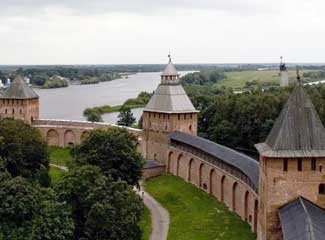Novgorod the Great
Novgorod - Lord Novgorod the Great - is  an early Russian polis of world fame, a legendary cultural centre - the largest in northern Europe until the 15th or 16th century, the birthplace of unique mediaeval architecture and a school of art.
an early Russian polis of world fame, a legendary cultural centre - the largest in northern Europe until the 15th or 16th century, the birthplace of unique mediaeval architecture and a school of art.
In the long argument between Ladoga, Novgorod and Kiev as to which was the first capital of Rus', preference should be given to Novgorod. At the dawn of the Russian state, Novgorod, first mentioned in the chronicles under the year 859, was an advance post of Rus' that quickly spread its influence to the south and east. This is due to Novgorod's special position in the hierarchy of Russian cities (its privileges were recorded in an early written law: the throne of Kiev was inherited by the prince who ruled in Novgorod) and an archaic form of democracy that endured in the city until 1478. According to one theory, the very name Novgorod - "new city" -is proof that somewhere nearby was the old capital, the Ar-Rusiya of Arab chroniclers (Ibn Khordabek, 9th c; Ibn Rust, early 10th c). Some believe that it was the remnants of its wood and earth fortifications, dating from the second half of the 9th century, that archaeologists found at the ancient Riurikovo gorodishche three kilometres from Novgorod.
It is hard to say what is truth and what is fiction in the ancient chronicles, but archaeological excavations over many years in Novgorod have produced much of interest. It emerged that the plain around Lake Ilmen was settled almost immediately after the glaciers receded, 5,000-6,000 years ago, but the first settlement with a earth rampart appeared here only in the 7th-8th century; that fast skis did not reach Rus' from Scandinavia, but vice versa; that the first wooden pavements appeared in Novgorod about 300 years earlier than in Germany or England (in northern Europe only those in the Scandinavian towns of Jutland were older); that Novgorod had the earliest water-main in northern Europe (11th c; London - late 14th c, Germany - 15th c). Literacy was common in Novgorod far earlier than in other parts of northern Europe. Probably for these reasons the very name given to the Novgorodian lands in mediaeval Europe (Ostrogard) was associated with a country "abundant in all blessings" (Adam of Bremen, 10th c).
 |
 |
 |
 |
 |
 |
